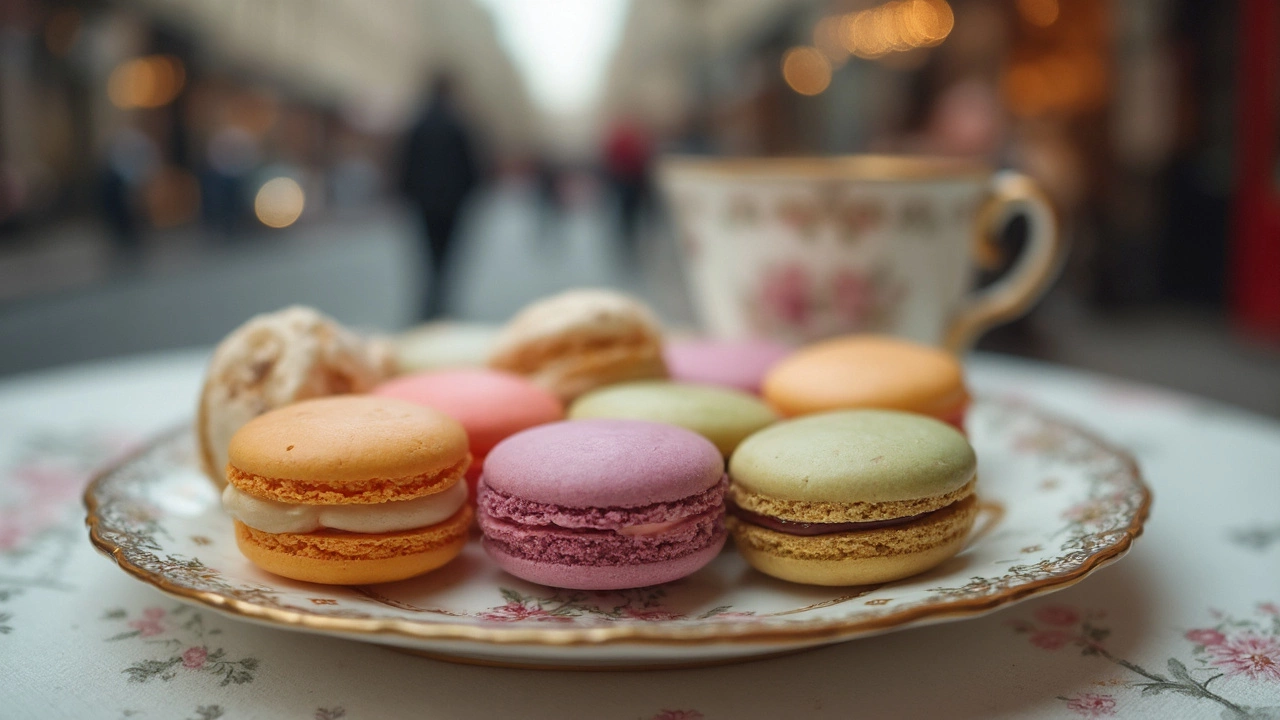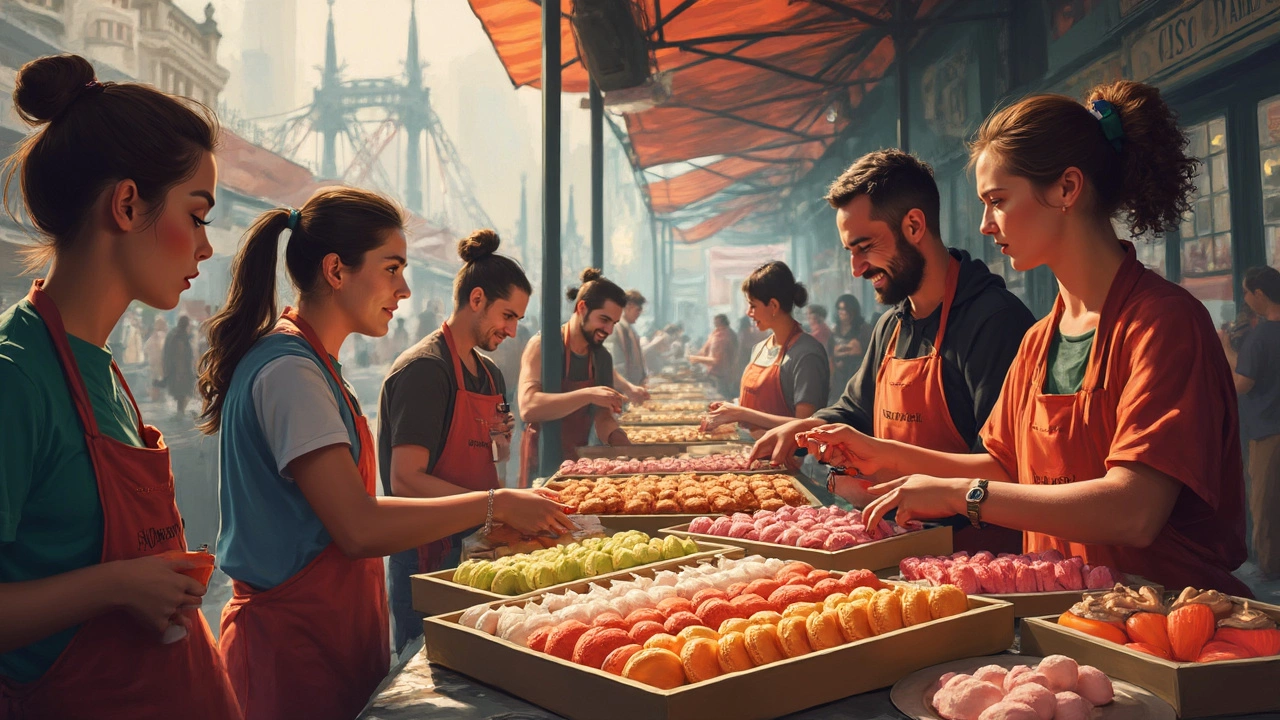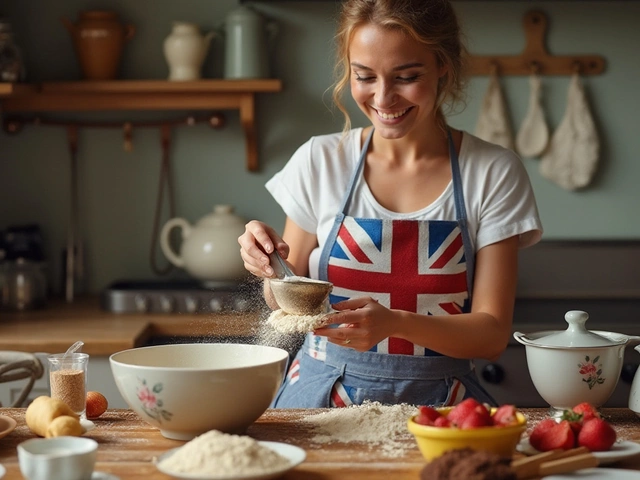If you're eyeing a stack of those colorful little macarons and wondering what a hundred of them might set you back, you're not alone. Macarons aren't just any dessert – they come with a price tag that's often a mix of art and science. These delightful treats have a lot more going on than meets the eye!
Let’s break it down a bit. The ingredients are the heart of the story. Almond flour, egg whites, and sugar sound simple, right? But these can be surprisingly expensive, especially if you’re aiming for top quality. Also, there’s a delicate balance in the process, almost like a chemistry experiment, to get those light-as-air bites.
But it doesn't stop at ingredients. The expertise required is no joke. Perfecting macarons can be tricky business, often taking bakers years to refine. This expertise contributes to their pricing, as it's not just about mixing things together—it's an art form.
- Understanding Macarons Pricing
- Key Ingredients and Costs
- Labor and Expertise in Macaron Making
- Macaron Packaging and Presentation
- Tips for Buying Quality Macarons
Understanding Macarons Pricing
When it comes to figuring out the price of macarons, it's not as simple as just adding up ingredients and labor. First, you've got the basic costs: almond flour, sugar, egg whites, and food coloring. High-quality ingredients can really add up. For instance, almond flour is typically more expensive than regular wheat flour because it’s made from ground almonds.
Another huge factor is the skill level required to make these little beauties. Unlike some other baked goods, macarons demand precision and experience to get that perfect, crunchy shell with a chewy interior. It's why many home bakers get frustrated at first and why expert bakers might charge more for their craft.
Presentation is also key in the world of macarons. It's not just about the taste but also the colors and how they're packaged. Bakeries often invest in fancy boxes and branding, which can affect the bottom line. Especially if you're buying as a gift, the packaging can make a big difference in how much you're willing to pay.
Pricing varies widely depending on where they're sold. For instance, in urban areas with high demand, like Paris or New York, you might see prices soar. But did you know that metro bakeries in Paris often retail macarons at around $2 per piece? That’s a $200 tag for a hundred!
Add seasonal flavors or limited edition creations, and prices might climb further. Think of these as the designer handbags of the dessert world. They’re delicate, special, and sometimes, a bit of an indulgence.
Key Ingredients and Costs
Let's get down to the nuts and bolts of macarons—the macarons' ingredients and their costs. It all starts with the core ingredients: almond flour, egg whites, and sugar. These aren't your run-of-the-mill items if you want quality.
First up, almond flour is the star here. It gives the macaron that unique, melt-in-your-mouth texture. But, it can be pricey, often costing double or triple that of regular flour. This is mainly because almonds take more resources to produce. Next, those egg whites. You might think, "Eggs, right? Easy peasy," but not quite. The eggs have to be at room temperature and fresh, no shortcuts there. Plus, you're only using the whites, meaning yolks often find another purpose or end up discarded, doubling your egg needs.
Sugar used in macarons is no ordinary table sugar. It typically involves both granulated sugar and powdered sugar, each serving a particular role in creating that delicate shell and sweet first bite. Quality does dictate price, so many bakers opt for premium brands.
Then you have optional flavorings and colors. These extras are where it gets fun but can quickly drive up costs. Want a hint of Madagascar vanilla or vibrant natural colors? Get ready to open your wallet a bit wider.
If you're mad about macarons and thinking of starting your own little operation, these ingredient costs are essential to keep in mind. Here's a little table to give you a quick glance:
| Ingredient | Approximate Cost (per kg) |
|---|---|
| Almond Flour | $15 - $25 |
| Sugar (Granulated & Powdered) | $2 - $4 |
| Egg Whites | $3 - $6 (per dozen eggs) |
| Vanilla Extract | $30 - $50 |
| Natural Food Coloring | $5 - $15 |
So, next time you bite into a perfectly crafted macaron, you’ll know exactly what goes into making these little luxuries. These costs show why every bite matters in macarons pricing.

Labor and Expertise in Macaron Making
Crafting macarons is no walk in the park. It's a mix of art, patience, and a lot of dedication. Many say it takes a skilled baker years to perfect the technique. So, why is it such a big deal?
First off, getting that perfect shiny shell with the delicate, chewy center is a tough nut to crack. It’s not just about following a recipe; the process involves precise measurements, perfect timing, and a lot of experience. Even the humidity in the room can affect the final product. Seriously, macarons are that sensitive!
A baker needs to have a sharp eye for detail. They must carefully whip and fold the batter just right to achieve the correct consistency. And oh, the piping! Sending out perfectly round, uniform circles takes steady hands and a lot of practice.
Now, let’s talk about the creative side. Sure, you can have basic vanilla or chocolate macarons. But the fun (and challenge) comes when crafting unique flavors and colors. Bakers often experiment with different fillings from fruity jams to creamy ganaches, adding a signature twist to each batch.
Lastly, there’s the quality control. Each batch has to maintain consistency, and that’s hours of work right there. All this labor and know-how naturally play into the cost. You’re not just paying for sugar and almonds; you’re paying for an authentic handmade experience.
Considering the difficulty and expertise needed, it’s no surprise that not every bakery chooses to delve into the macaron world. So, when you bite into one, remember it’s not just a sweet treat, it’s a testament to a baker’s hard work and talent. Next time you purchase a dozen or a hundred macarons, you’ll appreciate why they’re priced the way they are.
Macaron Packaging and Presentation
Ever noticed how macarons are always so beautifully packed? It's not just eye candy; it's a crucial part of the experience. The packaging of macarons isn't just for show; it serves practical purposes too.
First off, these delicate treats need proper protection during transit to avoid any unhappy accidents. A good box with a snug fit prevents them from bouncing around and losing their perfect shape.
The presentation of macarons is a big deal for anyone in the bakery business. It can make or break a sale. People often gift these, so having them in pretty boxes with a touch of elegance can really elevate a simple gift into something special.
"Presentation is as important as taste in the world of macarons. A beautifully presented macaron is irresistible," says Jean-Philippe, a renowned pâtissier.
There’s a science to it too—a mix of colors and flavors should look appealing when the box is opened. Arranging them by color or pairing shades that complement each other can enhance the visual impact. This is a trick many bakers use to make their macarons stand out in a fiercely competitive market.
And let's not forget about the branding impact. Bakers often use high-quality materials that can include branded ribbons or personalized notes. It’s those little touches that create more than just a taste memory, but also a brand memory.
Here’s a little tip: if you're buying macarons as a gift, check if the patisserie offers customizable packaging. Adding a special note or selecting a unique box can make your gift more thoughtful without much extra cost.

Tips for Buying Quality Macarons
Buying macarons might seem easy, but getting the best ones involves a bit of savvy shopping. These little delights are as complex in their making as they are in choosing the right batch to purchase.
First off, always look for freshness. A fresh macaron should have a slight crunch as you bite into it, followed by a light, soft interior. If it feels soggy or too crunchy, it might be old or poorly made.
Inspect the presentation. High-quality macarons will have smooth tops with no cracks and their famed "feet," the ruffly edges on the bottom. Mismatched colors or unfinished shells might be a red flag, indicating subpar craftsmanship or rushed production.
While it’s tempting to go for the cheapest option, do consider that pricing often reflects ingredient quality and the expertise involved. Those sold at significantly lower prices might be using inferior ingredients or shortcuts in the process.
Don't be shy to ask about the flavors. Bakeries with a good reputation usually offer a wide range of flavors, often with unique combinations that show creativity. This not only indicates variety but also the baker’s commitment to their craft.
If you have specific dietary needs, check if they offer options like gluten-free or vegan macarons. Authentic bakeries often cater to these needs, ensuring everyone gets to enjoy a piece without compromising on taste.
The baker’s reputation counts too. Get recommendations or check online reviews to ensure you’re buying from someone who knows their macarons. People love to share good experiences, especially with food this special.
Lastly, a fun way to ensure quality is to attend baking expos or macaron festivals. You’ll not only taste different varieties but also meet bakers who love talking about their delicious creations and often reveal what sets their macarons apart.





